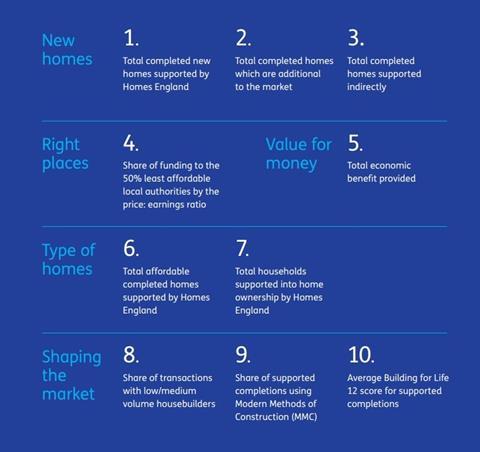Government body given ŌĆśrenewed and expanded missionŌĆÖ which could spell greater use of CPO powers for brownfield regeneration
Homes England will shift away from a ŌĆ£puristŌĆØ focus on housing supply towards regeneration, with performance judged by a much wider range of metrics including social value per pound of investment.
Harry Swales, chief investment officer at the agency, speaking ahead of the agencyŌĆÖs new five-year strategic plan published today, said Homes England will adopt a less ŌĆ£universalŌĆØ approach to funding schemes as it seeks more ŌĆ£ambitiousŌĆØ partnerships to shape places.

Its activity will be underpinned by 18 key performance indicators, covering supply metrics but also measuring design quality, sustainability, share of homes built using MMC, job creation, brownfield land use and share built by small businesses.
It will for the first time measure the social value per pound of investment, using the TreasuryŌĆÖs Green Book which includes consideration of the environmental, cultural, health, social care and other benefits to schemes.
Over the past five years Homes EnglandŌĆÖs performance has been judged on narrower criteria focusing on the economic benefits of schemes, including value for money.
Homes England boss Peter Denton had when appraising scheme scemes, in November 2021.
Swales said the agency, previously described as the governmentŌĆÖs ŌĆśhousing acceleratorŌĆÖ, has an ŌĆ£exciting opportunityŌĆØ to consider social value and supporting wellbeing in addition to the housing that is being delivered.
Swales said: ŌĆ£The last strategic plan was really quite focused on housing supply and was more purist on that front.ŌĆØ
He said Homes England will take a broader role over the next five years, potentially making greater use of its compulsory purchase order powers (CPO) and by establishing planning authorities.
ŌĆ£Those are all powers that are there and if you can see the assertiveness of the plan those are all things that continue to be reviewed, and if thereŌĆÖs appropriate points to use them IŌĆÖm sure thatŌĆÖs a conversation we will be having with the departmentŌĆØ, said Swales.
Swales said the agencyŌĆÖs new plan will allow it to respond to last yearŌĆÖs , which had a strong emphasis on regeneration, including a ┬Ż1.8bn brownfield fund, and devolution. He said Homes England will use its funding and expertise to help partners build a delivery plan for local areas.
He said Homes England, which will administer ┬Ż16.5bn of funding, will look to ŌĆ£bring forward brownfield land first to really drive regenerationŌĆØ. The agency intends to ŌĆ£tailor its powers, funding, expertise and technical capacity to the specific challenges faced in different areas.ŌĆØ
The strategic plan document published today says the agencyŌĆÖs ŌĆ£renewed and expanded missionŌĆØ will see it not just deliver homes but work with partners to ŌĆ£support the creation, regeneration, development and continued wellbeing of communities in England.ŌĆØ The agency will seek to enable access to sites for development, work with investors and provide expertise and support to developers, associations and the public sector.
Swales said: ŌĆ£One of the things that is really important to us is actually not just thinking about different funding programmes and assessing things individually, but actually bringing those together to respond to the priorities of a place.ŌĆØ
Homes England said it wants to see the master developer sector grow and will help master developers work in new parts of the country. It will also itself step into a master developer role where a clear need for one exists and other parties cannot do so, a role it currently fulfils in 20 schemes.
Swales also said Homes England will be ambitious about the quality of design and sustainability in homes it supports, although he said it would not set its own standards. He pointed to the agencyŌĆÖs ┬Ż175m greener homes alliance scheme with Octopus Energy ŌĆō which makes loans to SMEs housebuilders to help them deliver energy efficient homes - as an example of its approach.
Homes England will publish a ŌĆ£statement of intentŌĆØ on design quality and sustainability within the next six months, setting out a framework for ensuring this is embedded in its processes.
While the strategic plan outlines Homes EnglandŌĆÖs aims for the next five years, the agency also appears to be facing difficulties delivering on commitments under its current affordable homes programme.
The Public Accounts Committee of MPs last year with only 157,000 new homes out of an expected 180,000 set to be delivered.
Homes England in 2021/22 also . Many registered providers are understood to have been renegotiating their delivery numbers under the programme due to the economic turmoil of the last few months.
Swales said Homes England has had a ŌĆ£constructive conversationŌĆØ with providers over the past few months about ŌĆ£how we can shore up and optimise deliveryŌĆØ in the face of headwinds.
However he said it is ŌĆ£not appropriateŌĆØ to talk about where the programme is in terms of numbers of units delivered.
The Labour party which would see Homes England repurposed as part of its drive to deliver its housing pledges, including a 70% home ownership target.
Swales declined to comment on the policies but said there is a clear process by which the civil service engages with political parties in the run up to an election and said Homes England would have the ŌĆ£appropriate discussions at the right timeŌĆØ to prepare in case Labour wins the election.
Homes EnglandŌĆÖs new key performance indicators
Homes England five-year strategic plan includes 18 KPIs, encompassing a much wider range of outcomes than previously.
Strategic objective: Vibrant and successful places
KPI 1 Brownfield land reclaimed
KPI 2 Employment floorspace created
KPI 3 Number of jobs created
KPI 4 a) Total number of local authorities receiving in-depth capacity support from Homes England;
b) of which share who report improved capacity to deliver their place-based ambitions as a result
KPI 5 Social value per pound of investment
Strategic objective: Homes people need
KPI 6 Total number of housing completions directly supported
KPI 7 Total housing capacity of land unlocked by Homes England interventions
KPI 8 Total number of households supported into home ownership
Strategic objective: A housing and regeneration sector that works for everyone
KPI 9 Share of supported completions by low and medium volume builders
KPI 10 Share of supported completions using Modern Methods of Construction (MMC)
KPI 11 Total value of private sector funds leveraged through Homes EnglandŌĆÖs support
Strategic objective: Sustainable homes and places
KPI 13 ║├╔½Ž╚╔·TV performance ŌĆō share of supported completions that are EPC rating B or above
KPI 14 Average percentage biodiversity net gain planned on supported schemes
KPI 15 Indicator to be developed on embodied carbon of Homes England supported development
Corporate health
KPI 16 Share of partners reporting overall satisfaction with Homes England
KPI 17 Average colleague rating for Homes England being a diverse and inclusive employer
KPI 18 Number of principal risks outside risk appetite
Homes EnglandŌĆÖs previous key performance indicators
Below is the narrower criteria Homes EnglandŌĆÖs work was measured by in 2018 to 2023.



























No comments yet